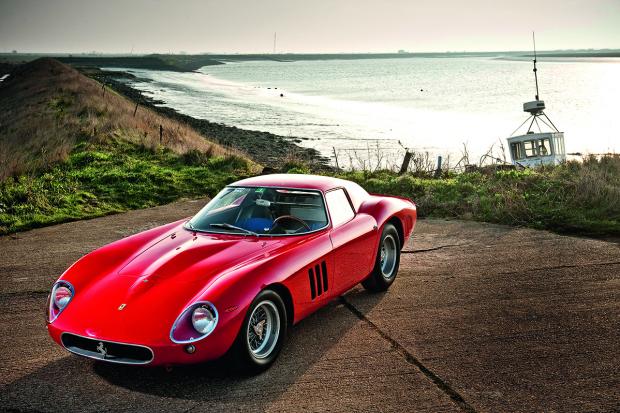The desolate Essex MoD site that we are let loose on is marginally less glamorous, just marginally, but provides an interesting counterpoint. Besides, this car has a habit of lifting its surroundings. Even in 1964 form, that shape is utterly bewitching. The reformed, still truncated tail with its pronounced sugar scoop bears more resemblance to the 250LM than early GTOs. That 275GTB-ish long nose and broader, squarer snout is smoother and better resolved, if less familiar without the three huge nostrils. Yet the shark-gills behind both front and rear wheels still instil its flanks with menace. Overall, the ’64 shape is both lower and wider than its forebear, and is almost like a stretched LM. See a profile shot of the latter, however, and what strikes you is how compact it is, how the overhangs front and rear are so equal, how the cockpit sits evenly between the axles like the vial on a spirit level. Not so the GTO. The overhangs are similar, but the perspective is distorted by how far towards the rear axle the cockpit is, the trailing edge of the door almost merging into the wheelarch, yet the leading edge is nearly halfway between the wheels. Add to that the steeply raked ’screen, tiny side windows and bulky C-pillar of a canopy dwarfed by the rest of the car and you have a classic long-bonnet, short-tail shape. Probably the classic long-bonnet, short-tail shape. Even so, it is the delicacy of details such as the finger-sized doorhandles, and how they merge into what should be freakish proportions played out in such dramatic curves, that charms the most.

That visual exaggeration is necessary, of course, because of what that front end needs to accommodate. The shape of the GTO may have changed dramatically, but mechanically it stayed virtually the same. The jewel in the crown is placed centrally beneath those tapering blades of rosso aluminium, and then under a beautifully symmetrical sextet of downdraught Weber 38DCNs, standing to attention like an infantry platoon. Lampredi/Colombo’s sensational 2953cc dry-sumped 60º V12 was carried over from the legendary Testa Rossa by Giotto Bizzarrini (then Mauro Forghieri, post-mutiny) and mounted in a tubular steel spaceframe based on a shortened – to 2400mm – 250GT SWB chassis. The sohc-per-bank V12 was mated to a five-speed ’box, with suspension by wishbones at the front and a live rear axle with leaf springs and a Watt linkage. Braking was via discs – which work well enough, but lack the fluid perfection of the rest of the car – and the whole was topped off with hallmark deep-dished Borrani wires.

A dozen trumpets top the sextet of twin-choke 38DCN Weber carbs, with crackle-black cam covers of the lightweight, sohc-per-bank V12 beneath










